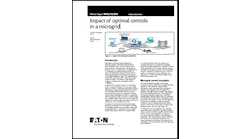Natural Gas Generators: Not Only Relevant but Critical to Microgrids
Generac’s Jamie Smith explores the importance of natural gas generators for today’s microgrids.
Jamie Smith, global vice president of business development, Generac commercial and industrial business unit
Despite the challenges of a global pandemic, interest in distributed generation solutions and microgrids continues to accelerate. A busy hurricane season and utility safety shutdown programs have commercial and industrial energy consumers seeking solutions that not only meet corporate sustainability objectives but also provide resiliency. Coupled with the increased value of distributed capacity in various energy markets, there is a growing demand for natural gas generators in microgrid systems.
A report published by Wood Mackenzie in July of 2020 identified 546 microgrids that were installed in 2019. Of that installed capacity, 86% included fossil fuel generation. So with the emergence of wind, solar and battery storage systems as viable and economical energy solutions, why is there still a significant demand for fossil fueled generators in microgrid projects? Simply put, there is a need for system resiliency that often outweighs sustainability objectives. A fossil fueled generator incorporated into a microgrid solution ensures that power will be there when needed over 99% of the time. In discussions with operators of facilities in industries such as healthcare, retail, manufacturing and quick service restaurants, they noted the importance of critical systems remaining online to service patients and customers or to prevent a substantial financial impact from loss of inventory or disruption in a manufacturing process.
While facility operators are looking at different solutions to provide resiliency or critical backup, they tend to keep sustainability in mind. As they evaluate options for fossil fired generation, they will quickly learn that environmental objectives can still be met using natural gas fueled generation to provide on-site power using reciprocating internal combustion engines. The emissions impact of a natural gas fueled solution can be up to 99% lower than its diesel counterpart when looking at NOx emissions. According to an NREL study, “Because natural gas engines often have significantly less sulphur and NOx emissions than comparable diesel engines, natural gas can more easily meet air quality requirements. This results in a simpler permitting process for natural gas compared to diesel.”
(Graph: Generac)
With the growth of the nation’s pipeline infrastructure, the availability of natural gas has increased, and it has become more economical. Since 2010, several reports have been published that state the reliability of the gas distribution pipeline is greater than 99.999%. In addition, the natural gas pipeline infrastructure in the US stores over 3.5 billion cubic feet and has the ability to isolate distribution and localize gas supply, ensuring several months of operation without any new production. During significant weather events, such as Hurricanes Irene and Sandy, many cases were cited in which critical systems supported by diesel generators ran out of fuel and were not able to get back online for days because of a breakdown in supply chain or hazardous conditions for refueling. In those same storms, sites that were reliant on the natural gas infrastructure continued to operate without disruption.
Natural gas generators are used in three primary applications when incorporated into a microgrid: combined heat and power (CHP), energy or load management, and as standby to a larger solution that may incorporate solar, wind, storage or other intermittent sources of power. CHP applications involve using the generator to produce electricity that may power a microgrid system while operating in both island-mode and grid-connected mode. In addition, the various sources of heat that are produced from the generator, such as the exhaust stream, are captured to create steam for heating, cooling and other processing needs locally. As a result, the overall efficiency of these systems can reach over 90% when comparing the calorific value of the amount of fuel entering the generator to the overall electrical and heat energy produced.
The emergence of system integrators that incorporate wind, solar, battery and generators into both custom and modularized microgrid solutions has been prevalent over the past 10 years.
Energy or load management microgrid systems are used to push power back to the grid or curtail energy consumption being served locally, such as peak shaving. Natural gas generators are often preferred in these applications as they can be relied upon to produce rated power when needed for an unlimited duration, unlike renewables that can often be intermittent or diesel generators with fixed fuel capacity. Over the past five years, there has been a trend to utilize a standby gas generator in applications beyond standby. With the emergence of software technology that can manage distributed energy resources (DERs) and create virtual power plants (VPPs), microgrids that utilize standby natural gas generators can be deployed as a DER in real-time energy markets and provide services to improve reliability, efficiency and overall grid performance. This has significantly decreased the cost of capital investment for an asset that is typically purchased as “insurance” in case of a power outage.
Sagehen Microgrid in California. Photo: Generac
The emergence of system integrators that incorporate wind, solar, battery and generators into both custom and modularized microgrid solutions has been prevalent over the past 10 years. These integrators range from large general and electrical contractors to small startup companies developing containerized solutions. Typically, their intellectual property is the software around system control and integration, and although the system is focused on a renewable solution, they often seek the resiliency of a fossil fuel generator. In California this past year, there were examples of microgrid systems consisting of solar and battery that were unable to perform because of smoke created by wildfires. Adding generation to the system ensures it can operate 24/7/365. In remote areas “off-grid” where a natural gas supply is not available, the microgrid can leverage the ability of many generators to operate on propane, LNG, CNG and other gaseous fuels.
Microgrid systems continue to become more attractive for commercial and industrial energy consumers, and renewable alternatives will remain top of mind. Natural gas generators integrated into a microgrid solution allow for an environmental friendly alternative that will ensure system reliability and enable opportunities to augment project returns. As companies consider their sustainability and resiliency plans, natural gas generators should continue to be an important part of the discussion.
Jamie Smith is the global vice president of business development for Generac’s commercial and industrial business unit.







